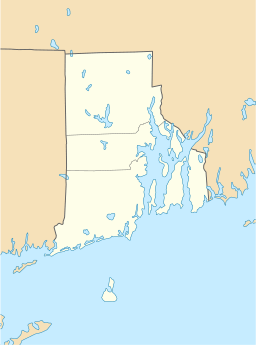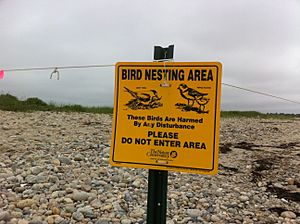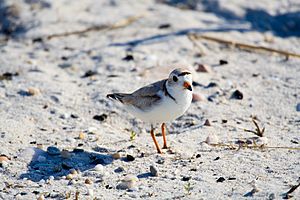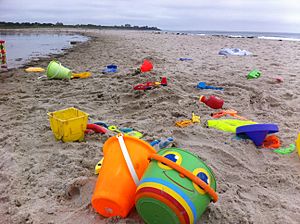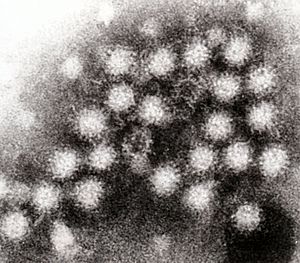Quicksand Pond facts for kids
Quick facts for kids Quicksand Pond |
|
|---|---|

The pond in 2009
|
|
| Location | Little Compton, Rhode Island |
| Coordinates | 41°30′23″N 71°07′48″W / 41.506493°N 71.130044°W |
| Lake type | Pond |
| Primary inflows | Simmons Pond, Cold Brook |
| Primary outflows | ephemeral outlet to the Rhode Island Sound |
| Basin countries | United States |
| Max. length | 1.5 miles (2.4 km) |
| Max. width | 0.75 miles (1.21 km) |
| Surface area | 158 hectares (390 acres) |
| Shore length1 | 7 kilometres (4.3 mi) |
| Surface elevation | 0 m (0 ft) |
| Frozen | in winter |
| Islands | 1 |
| 1 Shore length is not a well-defined measure. | |
Quicksand Pond is a pond located in Little Compton, Rhode Island. It is a very important place where fish like winter flounder lay their eggs. The pond is also home to rare plants and animals. It is part of a plan to create a natural pathway for wildlife.
Quicksand Pond is surrounded by special habitats. Many protected areas are right next to the pond. It is part of the Southeastern Coastal Watershed Basin. This pond is one of the most beautiful and untouched coastal areas in Rhode Island. Protecting it is a top priority. About half of the pond's shorelines are natural. The other half has private homes.
Contents
Bird Watching at Quicksand Pond
Quicksand Pond has large, often open, mudflats. These mudflats attract many shorebirds. They visit the pond during their spring and fall migrations. When the sandy barrier that usually separates Quicksand Pond from Rhode Island Sound opens, fresh wet mud appears. This mud attracts most of Rhode Island's shorebird species. Quicksand Pond was even named one of the "Top Five Must-See Migrations" in Rhode Island.
Many different birds spend time at Quicksand Pond. For example, a bird called a willet was seen here in 1882. There are also swans in the pond. The Quicksand Pond area is an excellent place for the least tern to breed. This is a rare shorebird that arrives in May. Other shorebirds, like sanderlings, great and snowy egrets, dunlin, and greater and lesser yellowlegs, rest on the mudflats and shoreline. A black rail is a very rare sight at Quicksand Pond.
The sandy beach habitat at Quicksand Pond is a good place for the American oystercatcher to nest. Saltmarsh sharp-tailed sparrows have also been seen here. Many waterfowl, like Canada geese, canvasbacks, American black ducks, and scaups, live or visit the pond. Quicksand Pond is known as one of the most important places for migrating waterfowl in New England.
The Piping Plover
The piping plover is Rhode Island’s rarest shorebird. These birds come to Quicksand Pond every April. They travel all the way from the Gulf Coast and the Bahamas.
Quicksand Pond is one of only five known breeding spots for the piping plover in Rhode Island. It has one of the largest groups of these birds in the state. On average, they have raised about 11 young birds each year over the last six years.
Goosewing Beach
Goosewing Beach is a 1.4 kilometres (0.87 mi) long sandy and rocky beach. It is at the southern end of Quicksand Pond. Its sand dunes are covered with plants like beachgrass and seaside goldenrod.
Goosewing Beach Preserve
The Goosewing Beach Preserve is a 75 acres (300,000 m2) protected area. It includes shore, ponds, and sand dunes. These dunes were formed 12,000 years ago by melting glaciers. It is considered one of Rhode Island's most beautiful places. A group called The Nature Conservancy manages it.
The Nature Conservancy and its partners bought the Goosewing Beach Preserve in 1989. They worked with the Little Compton Agricultural Conservancy Trust and the Rhode Island Department of Environmental Management. Since then, the Conservancy staff have actively worked to protect breeding piping plovers and least terns.
Goosewing Beach Preserve has received many honors. CNN called it one of the world's best eco-friendly beaches. The Boston Globe said it was a "Don’t Miss" place. Frommer's listed it as one of 500 places to see before they disappear.
The Benjamin Family Environmental Center
The Nature Conservancy of Rhode Island opened The Benjamin Family Environmental Center on July 11, 2010. This center has programs and displays. They teach about the many different types of habitats found in the Quicksand Pond and Goosewing Beach Preserve areas.
During the nesting season (mid-April to early-September), The Nature Conservancy hires special staff. These include a Plover Warden and a Goosewing Beach Preserve Manager. Their job is to watch over and protect the birds. They also help teach beach visitors about the sensitive wildlife living in the area.
A study at Goosewing Beach showed that mudflats are a favorite place for piping plover parents to raise their young.
The Gut
On the east side of Quicksand Pond, there is a small section called "The Gut".
Fishing in the Pond
You can find many types of fish and shellfish in Quicksand Pond. These include winter flounder, perch, American eel, soft-shelled clams, hard-shelled clams (also called quahogs), and American oysters. Herring have also been caught in Quicksand Pond.
Shellfishing Rules
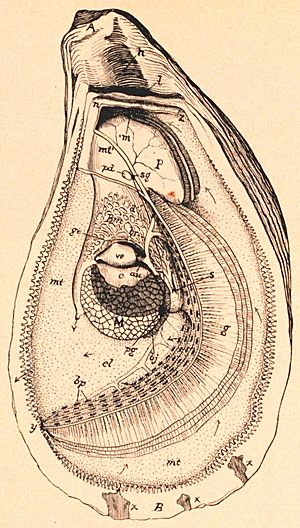
In June 1853, the state of Rhode Island made a change to a law. This law was about protecting oysters and other shellfish. The change said that Quicksand Pond would be considered a public place where people could collect oysters. It would follow all the rules of the law.
In 1965, there was "little change" in the number of wild oysters from Quicksand Pond. In 1968, a report called Shellfish survey of Quicksand Pond, Little Compton, R.I. was published.
Shellfish Safety Concern
In 2007, there was a concern about oysters from Quicksand Pond. The Rhode Island Department of Health investigated. They found that oysters collected by one fisherman from Quicksand Pond were involved. As the Health Department continued to investigate, they found no strong evidence of a problem. No one reported getting sick. Further tests did not show any significant signs of bacteria. About 50 bushels of oysters were held back and later destroyed to be safe. Today, Quicksand Pond is listed as "Un-assessed." This means that collecting shellfish there is currently not allowed.
Artistic Inspiration
Quicksand Pond has inspired at least two pieces of music. One song is called "Quicksand Pond" by Noreen Inglesi.
Images for kids


